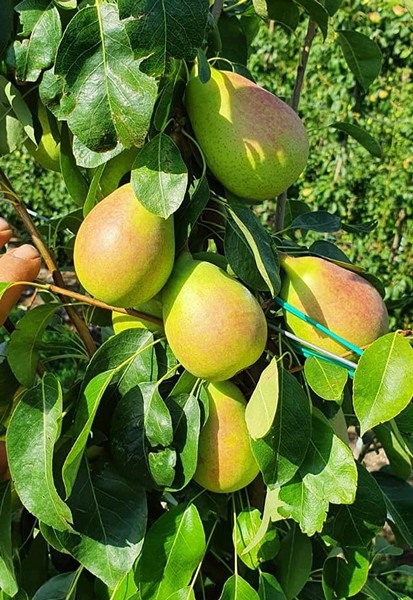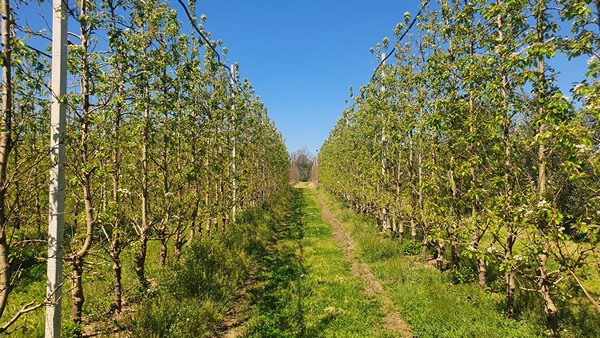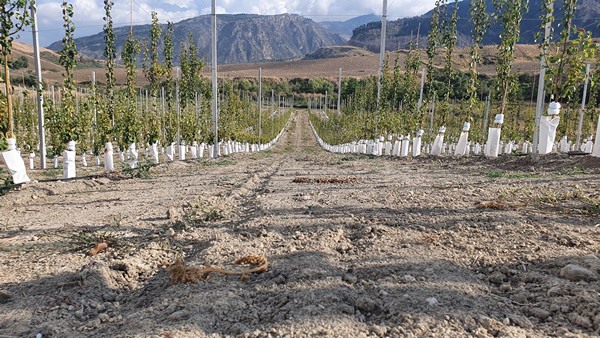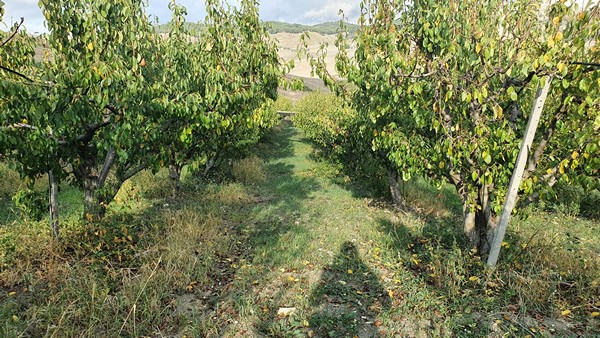In southern Italy, a modern technique that reduces costs while guaranteeing high quality standards is currently emerging in the pear-growing industry. The technique is that of highly intensive vertical cultivation in which all fruit-bearing branches grow on a main axis. The plants are spaced 0.60-0.80 meters apart per row. Between the rows there is 3.5-4.0 meters. This makes for about 4,000-4,500 plants per hectare.
 An orchard of Coscia pears in the third vegetative cycle (30 months old).
An orchard of Coscia pears in the third vegetative cycle (30 months old).
Agronomist Vito Vitelli is an advocate of this new cultivation model in southern Italy.
model in southern Italy.
Pictured on the right are Coscia pears with good size and with a color tending toward red due to sun exposure.
"Although within limited areas with even a limited acreage, we have nice examples in Sicily and Campania with exceptional results in just a few months. By lining up trees along an imagined wall, the pears receive more light. This promotes photosynthesis and thus the coloration of the fruit."
 Coscia pear trees grown in wall structure in Teano (province of Caserta)
Coscia pear trees grown in wall structure in Teano (province of Caserta)
"The plant material must be certified and supplied by approved nurseries. If the plant is thin, it is cut at a height of 40-45 cm to encourage a vigorous go-around. If the stem has a diameter of 12-15 mm, then it is left whole. In both the first and second case, a single branch develops, tied along a stick. Within 15-24 months it grows to a minimum of 2.5 meters and a maximum of 3.5 meters high as it were along the wall. The development is supported by a balanced supply of water and nutrients and by a sequence of cultivation interventions."

The structure of this innovative high-density planting consists of 3-4 iron wires stretched parallel to each other at an interval of 0.80 meters. The iron wires are supported by 4-meter-high concrete poles spaced 10-12 meters apart. There is also a drip irrigation system 30-40 cm away from the stem of the plant.
"During growth, there will be weak branches sprouting, of which some will already be bearing fruit after 2-3 years, on the one hand, and large, long and powerful branches on the other. The weak, fruit-bearing branches should be retained, and the vigorous ones pruned. This should be done in early autumn or late winter. It ensures a perfect balance along the central axis between the vegetative and generative strength of the plant. During the first years, pruning will also have to be done during the summer to better support the vegetative vigor of the young phase," continued Vitelli.
 Pear plot in the first vegetative cycle (less than 12 months old) in Castronuovo di Sicilia (province of Palermo)
Pear plot in the first vegetative cycle (less than 12 months old) in Castronuovo di Sicilia (province of Palermo)
The super-intensive cultivation technique is particularly beneficial for the Coscia variety, a typical summer pear in the Mediterranean area. "The fruit from these carefully pruned pear trees, with fruit-bearing branches that connect directly to the central axis, has good size, exceptional taste characteristics and a beautiful color, because the skin can benefit from great sun exposure. From its fourth year, each Coscia pear plant produces about 60-70 fruits with an average weight of about 120 g. This means 8-10 kg of pears per plant and, assuming 4,000-4,500 plants per hectare, a yield of about 30-35 tons/ha. In Sicily and Campania, the grower price of the Coscia pear is around €0.80-1.00 per kilo, which is €30,000-35,000 per hectare."
 Traditional planting
Traditional planting
"We need to move away from the traditional pear tree planting model, where a tree has 4-5 main branches and thus an excess of supporting wood structures tight to the trunk and fewer fruit-bearing branches. Despite its spaciousness, such a system is not conducive to aeration and proper distribution of plant protection products. Thus, harmful organisms can thrive better. This now outdated way of growing pears only discourages growers, as it results in high costs, low yields, complicated canopy management, many crop protection treatments, many residues and an inefficient planting density of 4m x 4m (600-700 plants/hectare)."
For more information:
Agronomo Vito Vitelli
+39 3392511629
vitovitelli@tiscali.it
vitovitelli.blogspot.com
